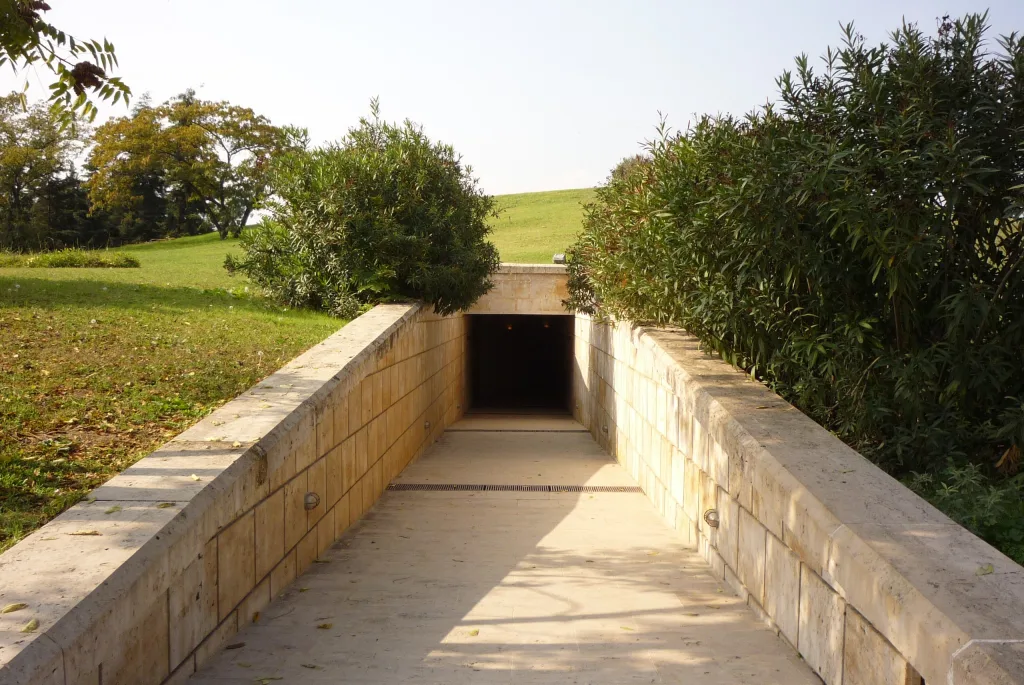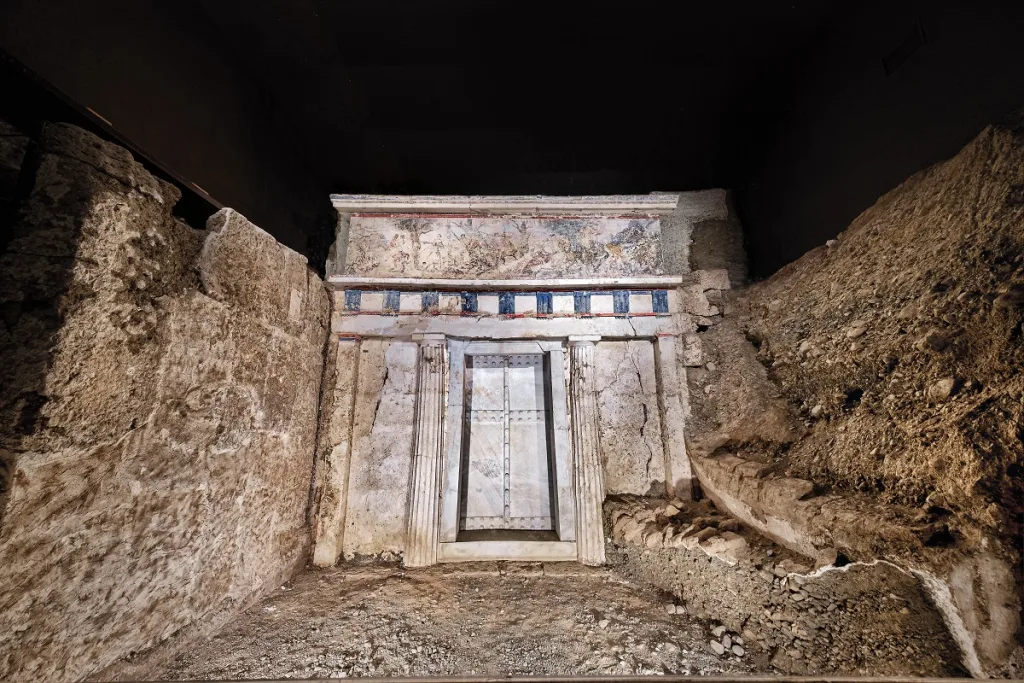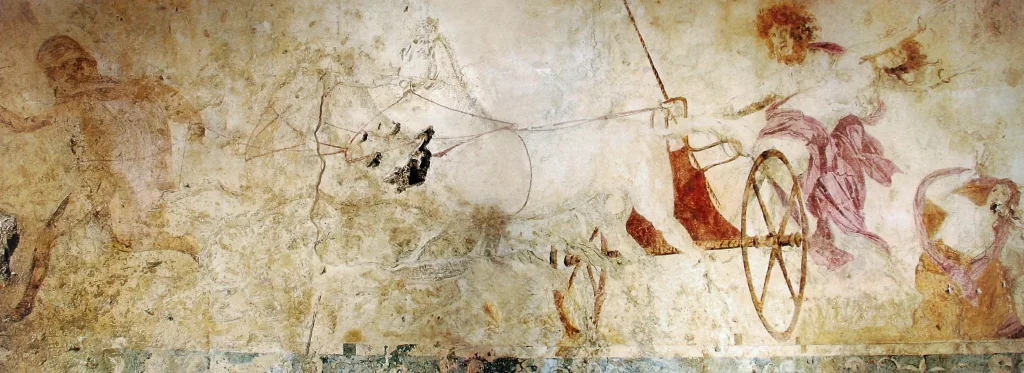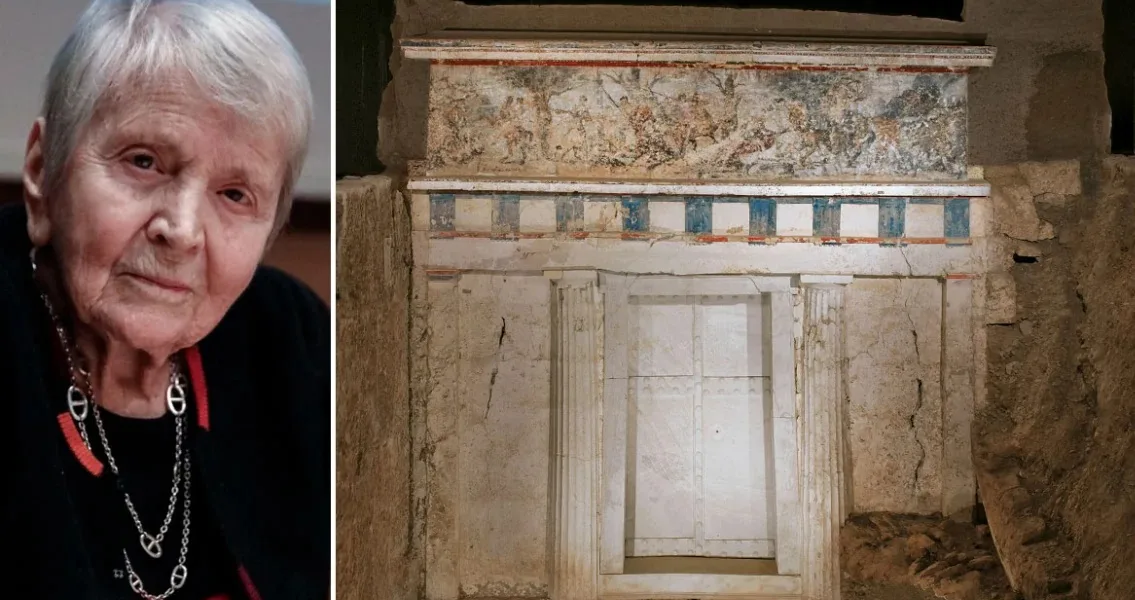Byzantine scholar Helene Glykatzi-Ahrweiler is certain that Philip II is not buried in the tomb at Vergina but instead Alexander the Great, a belief against the prevailing opinion of the Greek archaeologists.
Speaking to Culture Notebooks, she said that her claim "is a big thing I've done. I'm so sure" and lists six arguments to defend her claim
a) the ivory effigy of Alexander,
b) the representation in the frieze showing an action which, to be recorded, must have previously occurred,
c) Macedonian's original wish to be buried in his place,
d) the time gap from the burial in the place we know until the mausoleum is built,
e) the dead man's height, which, as she says, does not resemble the father's, but rather Alexander's own.
f) huntite, an Egyptian mineral found in the tomb.

In detail, the interview of Helene Glykatzi-Ahrweiler about the tomb of Alexander the Great in Vergina
For more than ten years, you have been talking about the royal tombs of Vergina, having a heretical argument, a position different from the one I held...
Different from all the Greek Archaeologists. Not the foreigners. Foreigners almost never accepted that the tomb belonged to Philip II. They talked about Philip the Arridaeus because everyone believed Alexander was buried in Alexandria. From there, we had to open all the sources about Alexander the Great and his burial to see what happened. When Manolis Andronikos, a great friend of mine, told me that he found Alexander's head in the so-called Philip's tomb, I asked him: "Is it possible that Vasileus Vasilevon is in a tomb?".
He replied that the tomb would either belong to Philip II or Philip II of Arridaeus or Alexander due to the dates. Still, Alexander the Great was buried in Alexandria. Arrhidaeus never went on a major campaign, so the one who lived was Philip II.
But when Amphipolis was found, everyone started saying that it might be the tomb of Alexander the Great. Then I said: "Since Alexander was buried in Alexandria, how can they say that the tomb in Amphipolis is his?" So, I started looking for where Alexander the Great was...
Based on your logic and argumentation, couldn't the existence of the statue of Alexander be a custom we are encountering for the first time?
These are modern Greek speculations. We know that the Macedonians wanted everyone to be buried in their homeland. We have many texts on this. But since Alexander the Great allegedly said he wanted to be buried in Alexandria, I also say: in Alexandria! When they found Amphipolis and started talking about Amphipolis, I wondered how it could be there since it is in Alexandria. But I started looking. And I saw that all the Ancients were wondering where he was buried.
In the funeral dialogues, Luciano writes: "Tell us, Alexander, where the Macedonians buried you". And, of course, Alexander doesn't answer. Everyone thinks they are in Alexandria. How and from where? When Ptolemy stole the pile, he almost took it from Damascus. What did the crowd at Damascus want if they went to Alexandria? It goes north and not south. I would like you to go to his place. Ptolemy takes her to Memphis to make a mausoleum. The mausoleum is made after 20 years. Until the mausoleum was built, the pile remained in Memphis. There, they burned the pile and collected the bones "according to the Greek way", i.e. they washed them with wine, etc. Those guarding the pile in Memphis are two Macedonians, thanks to whom - in my opinion - Perdiccas, the first commissioner after the death of Alexander, sent by Alexander's mother Olympias, managed to take him home.
Where do you support this position? Why are you making a guess…
First, the ivory head in the tomb. Second, the charioteer with Hippo in the middle, who must have been Alexander the Great, crowned. At both ends of the frieze are two hunters wearing hats. Ara is a hunt after the Persian presence of Alexander the Great. Could you let me know what's going on? The big difference between Eurydice – the wife of Arrhidaeus III – and Ptolemy with Olympias is how the body is buried when it arrives, thanks to Perdiccas in Macedonia. In order not to make Olympias triumphant, Eurydice chooses a discreet burial. And the interment takes place in the mound we know. Be that as it may, it would have been a big event if it had happened.
Even if Eurydice, as you say, wanted to keep it low-key, it would be discussed. It would have been written. It would have been rewritten, and there would have been sources...
We have not received anything from Alexander the Great's campaign chronologists. They have ruined everything. Besides, I maintain, regardless of all this, that when the Americans found a skeleton in the area of the mounds, which has a wound on the shin just like Philip II, they said that this was Philip and not the one in the so-called tomb of Philip.
First, the chest they found does not belong to the great Philip; Alexander was short.
Second, all the weapons refer to Alexander's armoury. Manolis (Andronikos) says that when he made the projection and showed the things to his colleagues, the archaeologists, those below shouted: Alexander.
"I would have said the same if I didn't know that he is buried in Alexandria," he said.
Condensing your claims, we have: a) the ivory effigy of Alexander, b) the representation in the frieze showing an action which, to be captured, must have previously occurred, c) we have the original Macedonian's desire to be buried in his place, d) we have the time gap from the burial in the place we know until the mausoleum is built, e) we have the height of the deceased which - you say - does not resemble the father's, but instead of Alexander himself. What else would you like to make the mainstream narrative?

The Houdite. A mineral of Egypt. What does he ask for on the skeleton of the so-called Philip? But also something else that only I find. Others don't say that. On the deathbed of the so-called Philip, there are two elephants. One shows a Satyr and the other Dionysus.
From Arrian, we know that when Alexander reaches Tyre, he cannot take it. There is resistance, and he wants to leave. In the evening, he sees a Satyr in his sleep, and as a student of Aristotle - says Arrian - he understands sa-Tyros. That is Tyros, yours. He stays and takes her. Then, when he handled everything, Alexander also went crazy and sent a decree to the Greek cities to make him God.
The Spartans accepted that he wanted to become God. But the Athenians said: "From where and to where?". Demas, a friend of Alexander in Athens, tells them: "Beware, whoever guards the sky, loses the earth."
The Athenians are afraid that Alexander will send any harm, and they named him Dionysus. Then Diogenes the Cynic went out into the marketplace and said: "Since you have made him Dionysus, you will make me Serapis."
So, what are a Dionysus and a Satyr doing on the deathbed of the so-called Philip? Also, where was all this luxury, the gold in the tomb, found? When the Macedonians went on campaign, they were in debt. Only debt. Where did they find him? While in Persia, there was a "mini-revolution" of the Macedonians who wanted to return to their homeland.

Alexander gathered them and told them: "You arrived barefoot, and now you are returning with so much gold".
So, however, we do it, we have to explain where the golden wreaths were found, in the tomb of the so-called Philip. So when the skeleton of Philippos was found by the Americans, with the wound on the shin, our people did not respond.
He tells you only Philip would have a shin injury? We found, and it is certain, the tomb of little Alexander, who Kassandros killed. The DNA of little Alexander is related to the one in the tomb of the so-called Philip. So they say it's Philip, the grandfather.
You have one more argument. You speak of a hurried movement of Alexander to a humble monument.
I'm not saying it. Andronikos says that the monument should be more luxurious. He explains that it was due to the Gauls' plundering when they arrived in Macedonia.
Ahrweiler, why do you think that for so many years that you have been putting this issue in the public debate, Archaeologists have not embraced it? Your position has been heard; as a person, you have a lot of influence. Are these arguments, for the experts, not sufficient?
It has not been allowed for at least 50 years that Greek archaeologists have Alexander and have never looked at it.
Are you implying that so many archaeologists do not admit it so as not to show a timeless deficiency in the interpretation and analysis of the data?
Of course...
Would you happen to think that your position will be vindicated?
When the next generation of archaeologists comes, from those who were on the dig and when I am no longer alive...
You are broadcasting a need to repeat that the so-called tomb of Philip belongs to Alexander the Great...
I need. It's the only authentic, significant thing I've done. I am so sure
READ MORE: The Oldest photo ever taken of the Acropolis and its history.


